What subject to trees?
Trees form all over the world and, in addition to showing their beauty, have discovered that research conserves curiosities. Among them are studies on the structure of the trees, the work to determine their age and the forest formed by a single tree discovered by DNA studies. The gomite is extended to anyone who wants to know more!
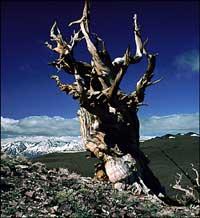
Sun exposure has a strange influence on plants. Those who put them in front of the kitchen window show it. From where the light feels, they try to move there. Plants also struggle to catch light in the forest. It is better to catch the sweet rays than to remain in the sadness of the shadow.
In this competition, trees are the masters. Some grow to look above any other plant in the environment, always asking for light. The branches extend as high as possible and, some, place the leaves at the ends so as not to become shade. The jungle is an extreme case in this struggle. The plants are divided into categories to live, as if they were in a house of many floors.
Those on the upper floors receive direct sunlight about 40 meters from the ground. There are also major changes in temperature. The descent reduces brightness. The vegetation of the soil has adapted to live in a dark way. The intermediate levels are also full of vegetation, each with its place.
Natural pillars
Physically, it can be said that this huge jungle structure is supported by tree trunks. Each tree has a spectacular structure. What has never been comfortable looking at a tree? In addition, it is not necessary to travel to the Amazon to find large and spectacular specimens. Almost all territories have tall and old trees. Many of them have also become symbols of a territory, such as the Gernika tree. On the Canadian flag the trees also have a special place.
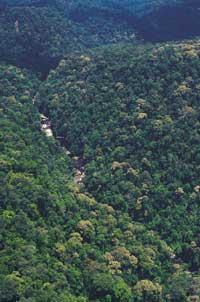
Among the tall trees, the most famous are the sequoias. Formerly they were widespread in a large area of North America, especially in the west of the continent. For the settlers these forests were a great discovery, but they were largely destroyed. The paradox was that the wood of the sequoias is not very useful. It is a fragile wood and therefore unsuitable for making utensils and for building houses. Due to this characteristic some sequoias were saved but others were cut.
On the other hand, these trees have contributed a lot of money to the Americans. With the creation of national parks, the largest sequoias found were protected. These specimens were very large, the tallest trees in the world. After drilling the trunk of one of these, a tunnel was built enough to pass the cars. Today it is a tourist attraction: Sequoia Park.
The highest documented sequoia is located in this California park of 112 meters. But there are many other trees in the world that stand out for their height. This past November a giant Tasmanian eucalyptus of 96 meters high has been unveiled. For lovers of natural records it must be said that it is the highest ever found in the southern hemisphere.
But history also has something to say. In other times trees have been documented higher than those we currently have. Among them, which we now know, the highest measured accurately arises in Australia. It was a 143-metre eucalyptus measured in 1885. Previously, Australia has also described a new eucalyptus that would probably exceed 150 meters, but unfortunately no exact measurement of this tree has been collected.
Giant blai
A giant plant of this type has a huge biomass divided into branches. In fact, in these branches a lot of water is condensed through mists. As the drops accumulate and fall to the ground, the surrounding vegetation easily survives, although it does not rain.
Normally, plants absorb water from the roots, which from the stem ascends to the leaves and from there evaporates into the atmosphere. Very large plants, however, do not have the same scheme. During wet days, the fog around the sequoias is sufficient to prevent evaporation that occurs through the leaves. In addition, this water supply system from the atmosphere is very effective. Therefore, it is easy to understand that the largest tree in the world survives so long.
Die or live
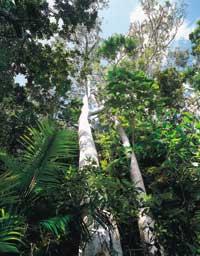
The age of trees also deserves attention. Undoubtedly, the oldest living beings are the trees. However, it is not easy to prove it. It is much easier to measure than height. It is known that the age of the trees can be known by cutting the trunk and counting the rings, but some problems arise.
To count the rings it is not necessary to cut the tree completely, that is, it is not necessary to kill it to know as much as is known. Special instruments can extract trunk fragments. If done well, do not harm the tree; in a few weeks the wound closes and that piece of trunk recovers. Sometimes, without taking samples, the age of a tree can be calculated from the thickness of the trunk itself. However, this method is not usually very precise, since the rings of the trees of the same species do not have the same width.
Each ring is a "residue" of abandoned wood in a year of the life of the tree; the years are not equal and, therefore, the "sign" deposited in the trunk is not equal. In some years the tree grows more or better than in others. If it has been a difficult year for growth, the ring that will remain will be narrow and in the 'prosperous' years wide. The good or bad year of growth depends on many factors, but perhaps the most influential is time. Therefore, in the logs you can read the trends of time.
But there are other data that can be extracted from the analysis of the rings. The only problem is interpretation. There is a field of science that deals with it: dendrochronology. The analysis of the same interval of years in many trees allows to investigate the characteristics of the stretch.
However, dendrochronology has many limitations. On the one hand, trees in many latitudes do not create rings. No wonder. Keep in mind that the closer to the equator, the less the seasons separate, and the winter to form rings is essential, since then the transport of water to the leaves is interrupted. In this pause the colors of the rings are "recorded". As winter does not occur in tropical regions, no rings are formed in trees.
To live forever?
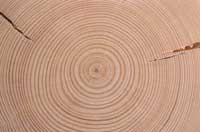
In Tasmania there is a strange living being. It actually has the form of a lot of old trees, but scientific studies do not say it. It seems that all specimens have the same DNA. Are they cloned trees? Trees and other complex living things do not create clones naturally. There is therefore only one explanation. The whole 'forest' is a unique and very ancient being. It is estimated to be about 4,600 years old. How has it been measured? The analysis of rings in larger trees is unreliable. But you can also study the fossil pollen of the tree and calculate the approximate age.
It seems that trees must grow continuously while no floods or fires occur. Most organisms suffer old age from a certain age. This age also has to do with the loss of reproductive capacity. If it does not reproduce, this live is not 'useful' to nature. But it seems that trees multiply and constantly advance. Is it true? Scientists claim that no trees older than 5,000 years are known as a result of natural disasters. A good subject to reflect, right?
Standing
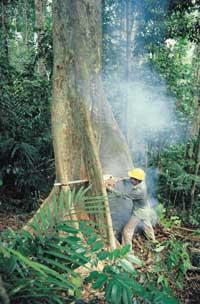
In the trees the trunk bears a very high weight. Therefore, it must be composed of rigid fibers. In large animals, the skeleton performs this function. Plants have invented another solution. Glucose molecules are formed by an internal structure placed one after another. In the liver of animals there is also a structure to store glucose and keep it handy when necessary. But this succession of hepatic glucose does not produce rigid fibers. What is the difference?
It consists in associating the difference between glucose molecules. The molecules have many grip 'arms'. By using one of these arms a soft matter is achieved that is easily liberable. It is therefore an exceptional system for use as guards. However, by grabbing another arm, straight and rigid fibers are formed, and the aizkolari also sweats a lot to cut it.
Published in the supplement Natura de Gara.
Buletina
Bidali zure helbide elektronikoa eta jaso asteroko buletina zure sarrera-ontzian











